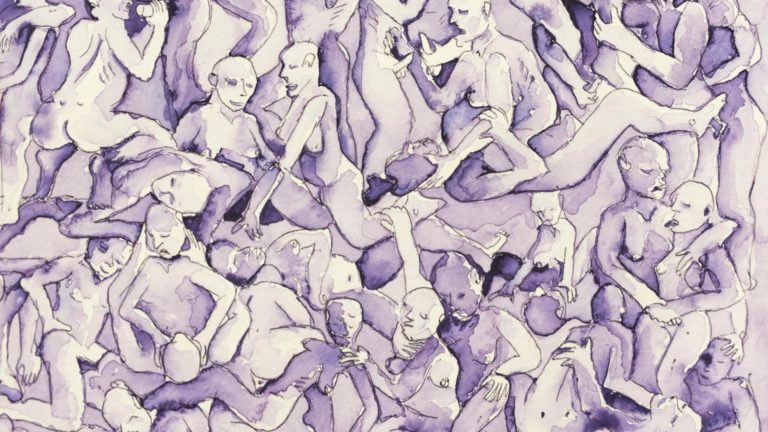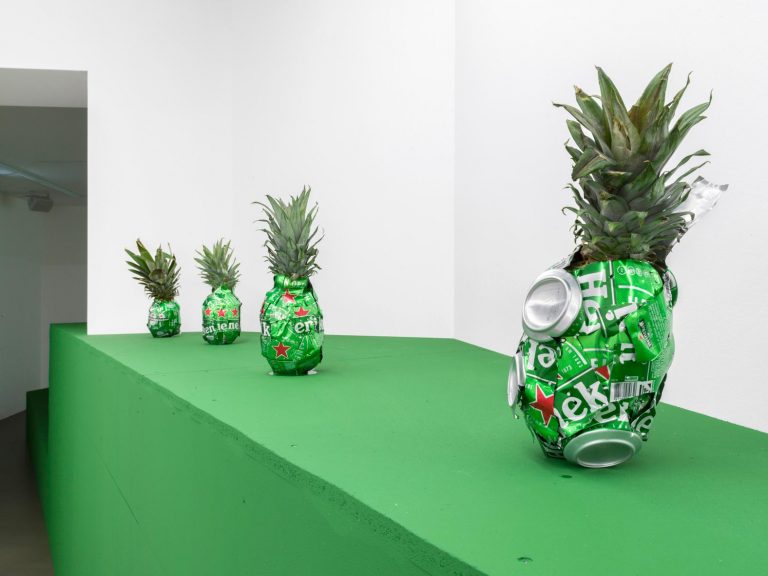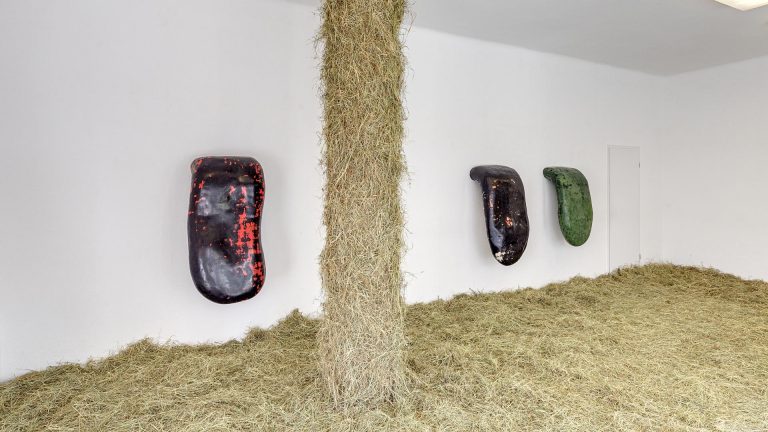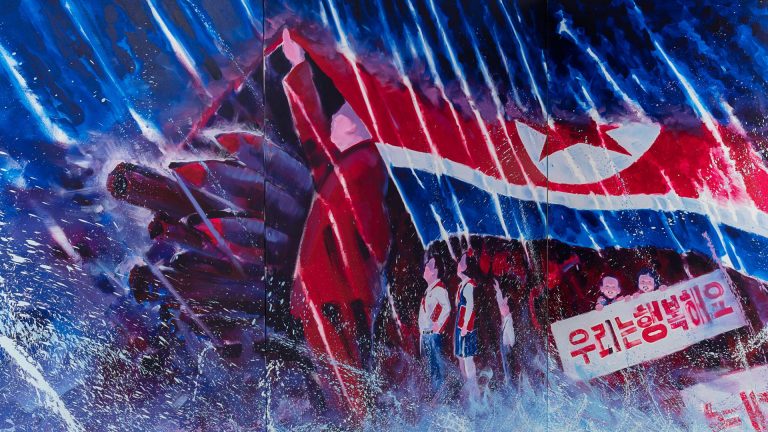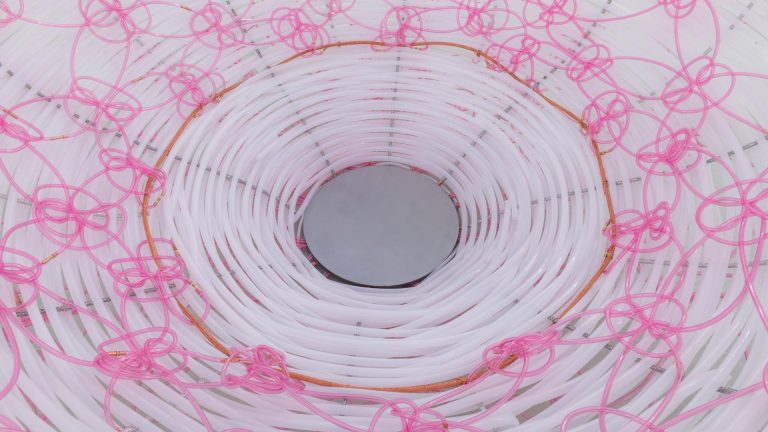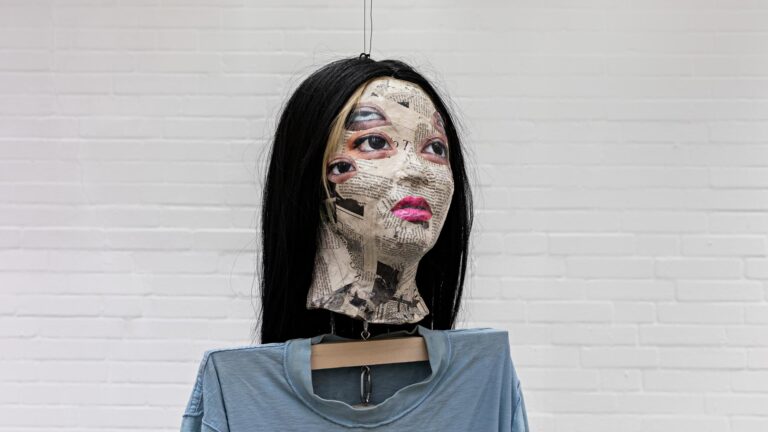Artist: Philip Gaisser with contributions by Katja Aufleger & Etienne Dietzel
Exhibition title: Line of Command
Venue: Galerie Conradi, Hamburg, Germany
Date: November 22, 2019 – January 11, 2020
Photography: all images copyright and courtesy of the artist and Galerie Conradi, Hamburg
A landscape, the encyclopedia Meyers Konversations-Lexikon defines in the early twentieth century, is any section of the surface of the earth that can be surveyed from a given vantage point, bounded by the horizon where earth and sky seem to abut. A man stands by a gate in a metal fence. A plastic bag containing golf balls is slung over a post. A precipice yawns in front of him; on the other side are hills, their slopes terraced. He tees up, adjusts his posture, takes a big swing, and hits the ball. A sequence of movements that is not real. The number of golf balls in the plastic bag changes from picture to picture; these are not photographs of one and the same drive. Still, that is the reading they suggest, and only a somewhat closer scrutiny reveals the difference. The logic of the sequence gives rise to a subtle counter-logic. So there are, on the one hand, interconnection and differential deviation, the continuity of a motion and its discontinuity, the interaction between one-point perspective and the secondary scenes in the image. But on the other hand, there is also the odd counter-logic with which this private driving range refills the artificial valley—the house in which the golfer lives stands on its edge—with golf balls.
A logic of progress is ingrained in humans’ relationship with nature. Man’s well-being rests on the utilization of nature and the creation of a landscape that corresponds to a human perspective, surveying, and standardization. These set a course that both enables and inhibits growth: meadows are aggregations of grass stalks on which animals graze, mountains are strip-mined or riddled with tunnels where valuable resources are buried under them, sand is a construction material. The landscape is a scenario of exploitation, part of an economic algorithm. On the one hand. But then, on the other hand, nature is also an infinite number of possibilities; any individual member of a swarm can change the entire swarm’s direction. In the golfer’s narrative, his position vis-à-vis the decommissioned mine remains questionable: it seems uncertain how long his lonely house will remain standing, so close to the steep edge of the pit, before it will fall victim to the landscape. His seizing on the opportunity presented by this menace for his pastime and slowly but surely filling the hole with golf balls at least prompts a few reflections.
So do other works in “Line of Command” that, with similar nonchalance, begin by showing what “is.” For example: diminutive and utterly abstract living creatures that, as part of an aging computer program in which human and machine learning coincide, are learning how to walk, wobbling on unsteady feet, an arduous process. A golf course that was brought into being simply by making a suitable map of an existing landscape, without adding anything to it or taking anything away. Beneath this landscape lie freshwater lakes. Sand gathered in hills above them that became overgrown with marram grass; they were left untouched because the sand is unsuitable for construction, the grass without agricultural value. Algorithms that are learning by imperceptible degrees the infinite number of possibilities of structuring a grassy landscape such that no stalk or tuft resembles another. Or a landscape that appears untouched even though, or precisely because, nuclear waste has been stored beneath it.
A landscape is not necessarily beautiful and permanent; it can also be temporary and ugly. The manner in which man imposes his economic and cultural regime on nature is contradictory, as are the temporal modes that underlie it. Humans and their apparatuses and technologies roam the natural world and exploit anything that is of any use (including what has already been used), be it as a likeness of the human soul, for recreational purposes, or as a source of prosperity. This perception of nature-as-landscape is—and how could it not be—always in the eye of the human beholder. When his perspective shifts just a little bit, the horizon loses its significance as the sole frame of reference, and a peculiar silence descends.
-Annette Hans
Philip Gaisser with contributions by Katja Aufleger & Etienne Dietzel, Line of Command, 2019, exhibition view, Galerie Conradi, Hamburg
Philip Gaisser with contributions by Katja Aufleger & Etienne Dietzel, Line of Command, 2019, exhibition view, Galerie Conradi, Hamburg
Philip Gaisser with contributions by Katja Aufleger & Etienne Dietzel, Line of Command, 2019, exhibition view, Galerie Conradi, Hamburg
Philip Gaisser with contributions by Katja Aufleger & Etienne Dietzel, Line of Command, 2019, exhibition view, Galerie Conradi, Hamburg
Philip Gaisser with contributions by Katja Aufleger & Etienne Dietzel, Line of Command, 2019, exhibition view, Galerie Conradi, Hamburg
Philip Gaisser with contributions by Katja Aufleger & Etienne Dietzel, Line of Command, 2019, exhibition view, Galerie Conradi, Hamburg
Philip Gaisser with contributions by Katja Aufleger & Etienne Dietzel, Line of Command, 2019, exhibition view, Galerie Conradi, Hamburg
Philip Gaisser with contributions by Katja Aufleger & Etienne Dietzel, Line of Command, 2019, exhibition view, Galerie Conradi, Hamburg
Katja Aufleger, Success Oriented Society, 2019, HD Video, Loop
Katja Aufleger, Success Oriented Society, 2019, HD Video, Loop
Katja Aufleger, Success Oriented Society, 2019, HD Video, Loop
Etienne Dietzel, Random Seed (5), 2019, C-Print, 134 x 92 cm
Philip Gaisser, Etienne Dietzel, No. 1, 2019, C-Print, 110 x 76 cm
Philip Gaisser, Korkeiche, 2018, C-Print, 91 x 76 cm
Philip Gaisser, LOC (Sandhills / Sandford), N°3, 2019, C-Print, 25 x 33 cm
Philip Gaisser, LOC (Sandhills / Sandford), N°4, 2019, C-Print, 55 x 42 cm, Detail of LOC, 2019, Installation, 16 C-Prints, Aluminum Profile, Glass, 90 x 700 cm
Etienne Dietzel, LOC (Sandhills / Sandford), N°6, 2019, C-Print, 30 x 40 cm, Detail of LOC, 2019, Installation, 16 C-Prints, Aluminum Profile, Glass, 90 x 700 cm
Philip Gaisser, LOC (Sandhills / Sandford), N°7, 2019, C-Print, 55 x 42 cm, Detail of LOC, 2019, Installation, 16 C-Prints, Aluminum Profile, Glass, 90 x 700 cm
Philip Gaisser, LOC (Sandhills / Sandford), N°9, 2019, C-Print, 25 x 33 cm, Detail of LOC, 2019, Installation, 16 C-Prints, Aluminum Profile, Glass, 90 x 700 cm
Philip Gaisser, LOC (Sandhills / Sandford), N°11, 2019, C-Print, 30 x 40 cm, Detail of LOC, 2019, Installation, 16 C-Prints, Aluminum Profile, Glass, 90 x 700 cm
Philip Gaisser, LOC (Sandhills / Sandford), N°14, 2019, C-Print, 30 x 22,5 cm, Detail of LOC, 2019, Installation, 16 C-Prints, Aluminum Profile, Glass, 90 x 700 cm
Philip Gaisser, LOC (Sandhills / Sandford), N°16, 2019, C-Print, 30 x 40 cm, Detail of LOC, 2019, Installation, 16 C-Prints, Aluminum Profile, Glass, 90 x 700 cm
Philip Gaisser, Chain of Command, 2019, C-Print, 91 x 117 cm
Philip Gaisser, SH, 2019, Zeichnung, 25,8 x 19,8 cm

























